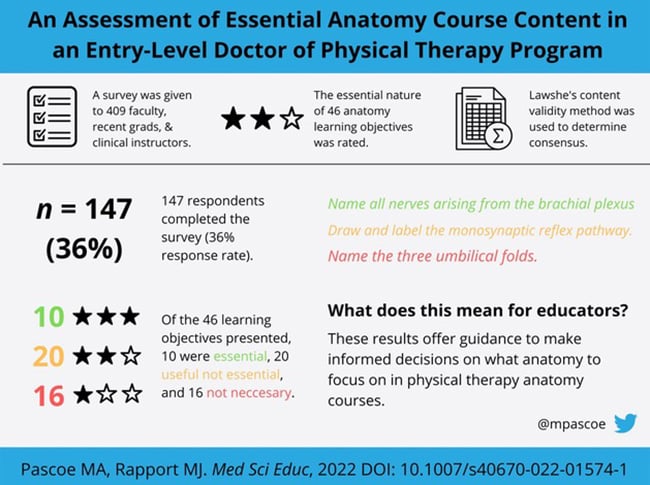Editor’s note: This is part of our periodic series of articles showcasing the creative talents of our faculty and students on the University of Colorado Anschutz Medical Campus. If you know of someone who is a “Creator in the Classroom,” please send us a tip here.
Physical therapists are experts in human movement and rehabilitation. In a profession dependent on human anatomy, these evidence-based clinicians evaluate patients and create treatment plans to help them restore movement, regain function and return to everyday activities. In some states, including Colorado, physical therapists may even diagnose functional conditions.

This graphic shows some results of the "essential anatomy course content" survey Mike Pascoe gave to physical therapy faculty, graduates and clinical instructors. |
With such a dynamic scope of practice, how do the physical therapy educators that are charged with preparing doctoral students for clinical care decide what anatomy to teach and what could be left out? Some may draw from their own clinical experience to make course content decisions, but non-clinical educators – who make up as much as 50% of all faculty teaching these courses – don’t have that luxury.
The latter scenario describes Mike Pascoe, PhD, associate professor of physical medicine and rehabilitation in the Physical Therapy Program at the University of Colorado School of Medicine.
After earning an undergraduate degree in kinesiology at CU Boulder, Pascoe stayed on campus and completed multiple teaching assistantships in the integrative physiology department while pursuing a doctorate in neuroscience. Transitioning directly from student to teacher, he accepted a faculty position at CU Anschutz where his primary appointment is to design and teach entry-level anatomy courses to doctor of physical therapy students.
‘The stakes are high’
“Physical therapists have a direct impact on patient care, so the stakes are high for their education,” he said. “I am not a physical therapist, so I’ve looked to my colleagues for advice on what course content is most valuable.”
Unlike most other healthcare professions, there are no published guidelines on what anatomical concepts are considered essential in physical therapist education.
|
Social Anatomy Educator Mike Pascoe, PhD, is a prolific Twitter user with more than 27,300 tweets on his professional account @mpascoe. A post about his anatomy course content study was retweeted nearly 300 times, making the rounds within the PT educator community and garnering interest from a handful of professional organizations.
Pascoe incorporates social media into his teaching, both directly and indirectly. He found his Snapchat (@AnatomySnap) to be particularly valuable for helping his physical therapy students practice information retrieval without the aid of learning materials. In 2019, he surveyed students’ satisfaction with his snaps, which summarized blood-flow pathways of the lower limb and collected data to determine if their exam scores improved. Pascoe found not only that his students were satisfied with the content, but when compared to students without access to the snaps, that their knowledge retention was significantly better. Read the study, published in the Federation of American Society of Experimental Biology’s FASEB Journal, here. |
“It’s a big topic for education in general – weeding out the unnecessary. We as educators have had to determine what anatomy education looks like, what is being covered and what we need to describe about the organization of the human body,” Pascoe said. “Since there was no baseline, I wanted to establish one.”
To do that, he turned to research. Pascoe invited a diverse group of 409 faculty, recent graduates and clinical instructors to answer a survey rating 46 learning objectives. The survey had a 36% response rate, with 147 respondents completing all questions. Of the learning objectives presented, 10 were most frequently ranked “essential,” 20 were “useful but not essential” and 16 were deemed “not necessary” by respondents.
'A double-win’
Pascoe considered the study a “double win”: not only would his students directly benefit from the findings, but his research also made for an excellent capstone project to culminate his participation in CU’s 18-month Teaching Scholars Program. The study, co-authored by Pascoe’s Teaching Scholars mentor Mary Jane Rapport, PT, DPT, PhD, FAPTA, who retired from the program in February, was published in the June 2022 issue of Medical Science Educator.
“We have a finite amount of time to prepare these students. The study provided me with a great data set, and I know what objectives to emphasize and spend more time on,” Pascoe said.
Beyond a personal impact, Pascoe said the results will offer guidance for other anatomy instructors to make informed course content decisions and dedicate more time to content that will better prepare their physical therapy students for clinical care.
“I’ve found it’s resonating with educators – it’s a big question that a lot of my colleagues have,” he said.
Jessica Ennis is a special contributor.



